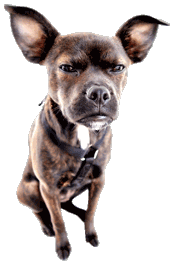At AllThingsNature, we're committed to delivering accurate, trustworthy information. Our expert-authored content is rigorously fact-checked and sourced from credible authorities. Discover how we uphold the highest standards in providing you with reliable knowledge.
What is a Great Dane?
The Great Dane is a giant breed of smooth-coated dog. Only the Irish Wolfhound is taller than the Great Dane. Despite its huge size, the Great Dane is known for having a gentle nature that has earned this dog breed the nickname of "Gentle Giant."
The Great Dane breed was developed by mixing Greyhound and English Mastiff breeds. The Great Dane has nothing to do with Denmark, but was developed in Germany and England. Apparently, a French naturalist saw the breed in Denmark and the name Grand Danois, or Great Dane, stayed. The Great Dane is also called the Deutsche Dogge, or German dog.

Socialization of all dogs is important, but since the Great Dane often weighs more than some humans, early and proper socialization of this giant breed is absolutely crucial. After all, you have to be able to walk your dog, not let your dog walk you! Proper socialization means that the dog is not taken away from its mother too early and is exposed to all types of animals and people from a young age.
In general, the Great Dane breed is known for having a calm disposition and that, plus its size, makes this breed desirable to use as helper dogs for physically disabled people. The Great Dane is a social breed that doesn't like to be left alone for too long or it may cause damage to property. These dogs are not made to be outdoor dogs and usually have thin coats. Surprisingly, the Great Dane is considered to be a good apartment dog as long as it gets two walks daily. Great Danes are not known for excessive barking.
Great Danes are easy to groom and they don't shed very much. The Great Dane coat is smooth, but thick and short, and usually does well with a combing using a grooming mitt or a brushing with a soft-bristled brush once a week. Six Great Dane coat colors are recognized by the American Kennel Club: Black, Mantle, Harlequin, Fawn, Brindle and Blue. The Blue is a gray-blue, the Mantle is black and white and the Harlequin is white with black patches. Giant dog breeds often need feeding twice a day as adults and raised dishes are often recommended for giant breeds to save strain on shoulder joints and to help ease digestion.
Frequently Asked Questions
What is the origin of the Great Dane breed?
The Great Dane, known for its grand size and gentle demeanor, has its origins in Germany, despite the name suggesting a Danish background. Bred as a boar hound, its ancestors include the old English Mastiff and the Irish Wolfhound. Over time, the breed was refined to the noble and friendly giant we recognize today.
How big can a Great Dane get?
Great Danes are among the tallest dog breeds, with males typically standing between 30 to 34 inches at the shoulder and weighing around 140 to 175 pounds. Females are slightly smaller, usually measuring 28 to 32 inches tall and weighing about 110 to 140 pounds. Their impressive stature is one of their most distinguishing features.
What is the lifespan of a Great Dane?
Despite their grandeur, Great Danes have a relatively short lifespan. On average, they live between 7 to 10 years. Proper care, nutrition, and regular veterinary check-ups can help maximize their lifespan. It's important for potential owners to be aware of this commitment before bringing a Great Dane into their home.
Are Great Danes good with children and other pets?
Great Danes are known for their affectionate nature and patience, making them excellent companions for children. They are generally good with other pets as well, especially when socialized from a young age. However, due to their size, supervision is recommended around small children and animals to prevent accidental injury.
What kind of exercise does a Great Dane need?
Despite their size, Great Danes are not excessively energetic. They require moderate exercise to maintain their health and happiness. Daily walks and the opportunity to stretch out in a secure area are sufficient. It's important to avoid over-exercising puppies, as their bones and joints are still developing.
What are some common health issues in Great Danes?
Great Danes are prone to certain health issues such as hip dysplasia, heart conditions like dilated cardiomyopathy, and bloat, which can be life-threatening. Bloat, or gastric torsion, is particularly concerning for deep-chested breeds. Preventative measures include feeding smaller, more frequent meals and avoiding exercise around feeding times to reduce the risk.
AS FEATURED ON:
AS FEATURED ON:










Discuss this Article
Post your comments